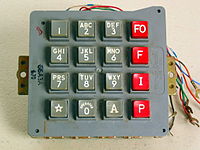
Photo from wikipedia
Spasticity affects approximately 65% of persons with spinal cord injury (SCI) and negatively impacts function and quality of life. Whole body vibration (WBV) appears to reduce spasticity and improve walking… Click to show full abstract
Spasticity affects approximately 65% of persons with spinal cord injury (SCI) and negatively impacts function and quality of life. Whole body vibration (WBV) appears to reduce spasticity and improve walking function; however, the optimal dose (frequency/duration) is not known. We compared single-session effects of four different WBV frequency/duration dose conditions on spasticity and walking speed, in preparation for a planned multi-session study. Thirty-five participants with motor-incomplete SCI received four different doses of WBV: high frequency (50 Hz)/short duration (180 s), high frequency/long duration (360 s), low frequency (30 Hz)/short duration, and low frequency/long duration, plus a control intervention consisting of sham electrical stimulation. In all conditions, participants stood on the WBV platform for 45-s bouts with 1 min rest between bouts until the requisite duration was achieved. The frequency/duration dose order was randomized across participants; sessions were separated by at least 1 week. Quadriceps spasticity was measured using the pendulum test at four time points during each session: before, immediately after, 15 min after, and 45 min after WBV. Walking speed was quantified using the 10-m walk test at three time points during each session: baseline, immediately after, and 45 min after WBV. In the full group analysis, no frequency/duration combination was significantly different from the sham-control condition. In participants with more severe spasticity, a greater reduction in stretch reflex excitability was associated with the high frequency/long duration WBV condition. The sham-control condition was associated with effects, indicating that the activity of repeated sitting and standing may have a beneficial influence on spasticity. Trial registration: NCT02340910 (assigned 01/19/2015).
Journal Title: Neurotherapeutics
Year Published: 2018
Link to full text (if available)
Share on Social Media: Sign Up to like & get
recommendations!